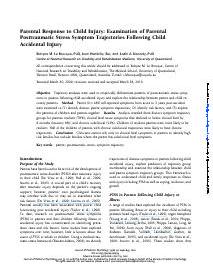Parental Response to Child Injury : Examination of Parental Posttraumatic Stress Symptom Trajectories Following Child Accidental Injury
Objective: Trajectory analyses were used to empirically differentiate patterns of posttraumatic stress symptoms in parents following child accidental injury and explore the relationship between parent and child recovery patterns.
Method: Parent (n = 189) self-reported symptoms from acute to 2 years post accident were examined to (1) identify distinct parent symptom trajectories; (2) identify risk factors; and (3) explore the patterns of children and parents together.
Results: Analysis revealed three distinct symptom trajectory groups for parents: resilient (78%); clinical level acute symptoms that declined to below clinical level by 6 months (recovery 8%); and chronic subclinical (14%). Children of resilient parents were most likely to be resilient. Half of the children of parents with chronic subclinical trajectories were likely to have chronic trajectories.
Conclusion: Clinicians cannot rely only on clinical level symptoms in parents to identify high risk families but include families where the parent has subclinical level symptoms.
Geachte bezoeker,
De informatie die u nu opvraagt, kan door psychotraumanet niet aan u worden getoond. Dit kan verschillende redenen hebben,
waarvan (bescherming van het) auteursrecht de meeste voorkomende is. Wanneer het mogelijk is om u door te verwijzen naar de bron
van deze informatie, dan ziet u hier onder een link naar die plek.
Als er geen link staat, kunt u contact opnemen met de bibliotheek,
die u verder op weg kan helpen.
Met vriendelijke groet,
Het psychotraumanet-team.
35 | 6 | 646–655
https://doi.org/10.1093/jpepsy/jsq035


